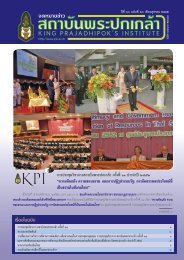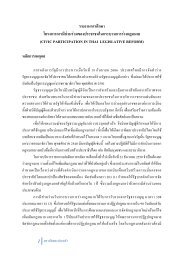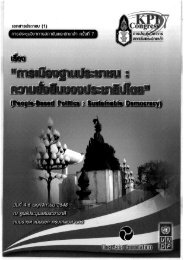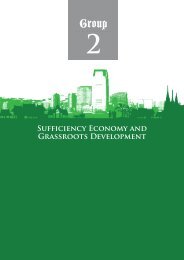Conflict, Legitimacy and Government Reform: Equitable Allocation of ...
Conflict, Legitimacy and Government Reform: Equitable Allocation of ...
Conflict, Legitimacy and Government Reform: Equitable Allocation of ...
You also want an ePaper? Increase the reach of your titles
YUMPU automatically turns print PDFs into web optimized ePapers that Google loves.
48 KPI Congress XI<br />
accelerated rate, income <strong>of</strong> workers in these fields increased at a faster<br />
rate compared to other fields, leading to inequality.<br />
Third, in urban areas, income <strong>of</strong> workers in different occupations<br />
varies. Skilled workers can increase their wages above unskilled workers<br />
<strong>and</strong> pr<strong>of</strong>its <strong>of</strong> employers who are factory owners increase at an<br />
accelerated rate, thus widening inequality.<br />
Up to a certain point, these inequality would decline gradually due<br />
to several reasons. For instance, when saving concentration dissipates<br />
because other groups have higher income <strong>and</strong> higher saving<br />
opportunities. At the same time, new groups with greater economic<br />
power that become successful dem<strong>and</strong> the government to implement<br />
public policies to mitigate income inequality.<br />
As for Thail<strong>and</strong>, Duangmanee Laowakun applied Kuznets’ method<br />
to calculate income level that might be a turning point that could reduce<br />
income inequality value. It was found that this probable threshold might<br />
be the income per capital <strong>of</strong> 45,215 baht in 1994 (Duagmanee <strong>and</strong><br />
associates, 2009: 3-22) 2 <strong>and</strong> it was found that genie coefficients showed a<br />
declining trend during 1991-1998 but the values perked up again in<br />
2000 <strong>and</strong> 2006. Therefore, such turning point did not really occur.<br />
Why has income distribution inequality in Thail<strong>and</strong> not been<br />
reduced as envisaged in Kuznets’ study?<br />
History tells us that there are two different approaches to mitigate<br />
income inequality. One way is to use taxation <strong>and</strong> money transfer to<br />
create wealth <strong>and</strong> income equality. Another approach is to allow social<br />
forces to exert pressure to mitigate inequality, for example, a labor union<br />
succeeds in negotiating for a higher wage with the employer. In practice,<br />
many countries use both approaches, that is, having both public policy<br />
<strong>and</strong> social pressure.<br />
The countries studied by Kuznets showed a more equitable income<br />
distribution because those in power, that is, governments were pressured<br />
2 Pranee’s study (2002) also adopted Kuznets’ concept. It was found that the turning<br />
point likely occurred in 1993 when annual income per capita was 40,436 baht.














